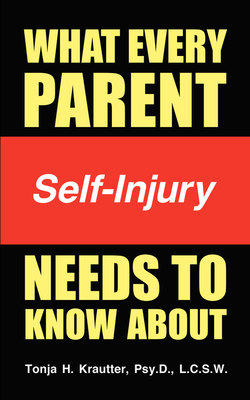Читать книгу What Every Parent Needs to Know About Self-Injury - Tonja Krautter - Страница 11
На сайте Литреса книга снята с продажи.
Feelings and Cognitions Associated with Self-Injury
ОглавлениеIndividuals who self-injure often experience feelings of worthlessness or “inner badness.” They frequently feel sad and “empty” inside. They may ruminate about death and dying, and ponder the usefulness of their lives. Nadia felt this way and relates, “I felt so empty inside that I often wondered if life was worth living. Self-injury helped me feel much more alive. It helped me feel something.”
The self-injurer is often very fragile even if she presents as someone who is self-confident and strong. Amber, age 16, explains, “I have been battling depression for almost two years now, but you would never know by just looking at me.” Most people see Amber as self-confident, beautiful, intelligent, and athletic. This led to her feeling misunderstood, invalidated, and unheard in many circumstances; all perceptions commonly cited by individuals who self-harm.
The way in which a self-injurer thinks and the way she feels seem to go hand in hand. Self-injurers characteristically have a particular thinking style. Their cognitions are focused on extremes, which is often referred to as “all or nothing” thinking. This dichotomous thinking style places the self-injurer at high risk for low self-esteem. Since there is no grey area within the dichotomy, the individual sees herself as either all good or all bad. With little room for partial gratification, it also sets the individual up for continual disappointment, particularly in relationships with others.
The self-injurer’s self-esteem is highly dependent on external forces. Family, culture, and peer groups are all very influential in the lives of self-injurers, making them vulnerable when around these subsystems, particularly if they are feeling misunderstood. Joey comments, “I often blamed myself for events that were outside of my control and rarely took responsibility for my own actions and their consequences.” Joeys’ motivation to be successful came from the need to please others, not from within. He felt frequently hurt and disappointed in himself and those around him. Upon experiencing disappointment, he self-harmed to manage his feelings of “inner badness.”
Lastly, the individual who self-injures often experiences great confusion, guilt, and shame for her actions. Nadia began cutting when she was 11 years old. She remembers the first day the problem began. She came home from school and heard her parents fighting. Their arguments had escalated in the past several months to an intensity that was overwhelming for her. As she stood in the laundry room listening to the anger and hostility that emanated from the room next door, she broke down and cried. However, her tears did not relieve the tension building inside of her.
As her tension increased so did her desire to do something about it. She desperately wanted to find a way “to make it go away.” Without thinking, she frantically grabbed for a pair of sewing scissors that was on top of the washing machine and jabbed the pointed edge into her thigh. She immediately felt the pain, which began to pulsate through her leg. She watched the blood flow slowly “like a peaceful stream” down her thigh, across her ankle and onto the floor. Nadia stared at the blood and focused on her physical pain as a way to avoid her emotional distress. She was pleased that she no longer felt helpless in her situation and marveled in her newfound sense of control. It was at that very moment she knew she would self-injure again despite the fact that she knew what she was doing was wrong. The good feelings self-injury gave her outweighed the guilt and shame she experienced during and after the act of self-harm.
